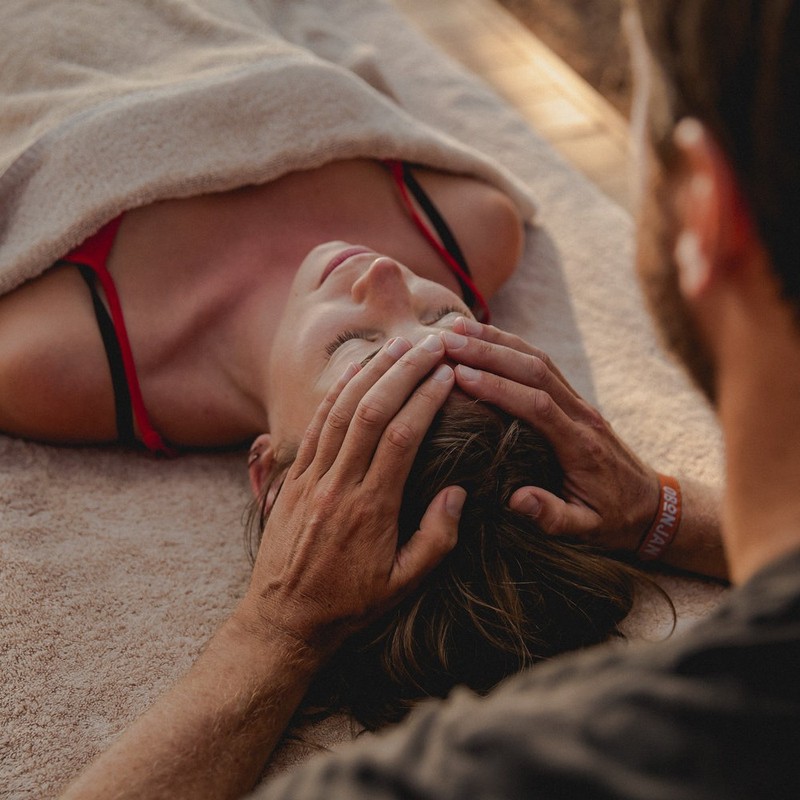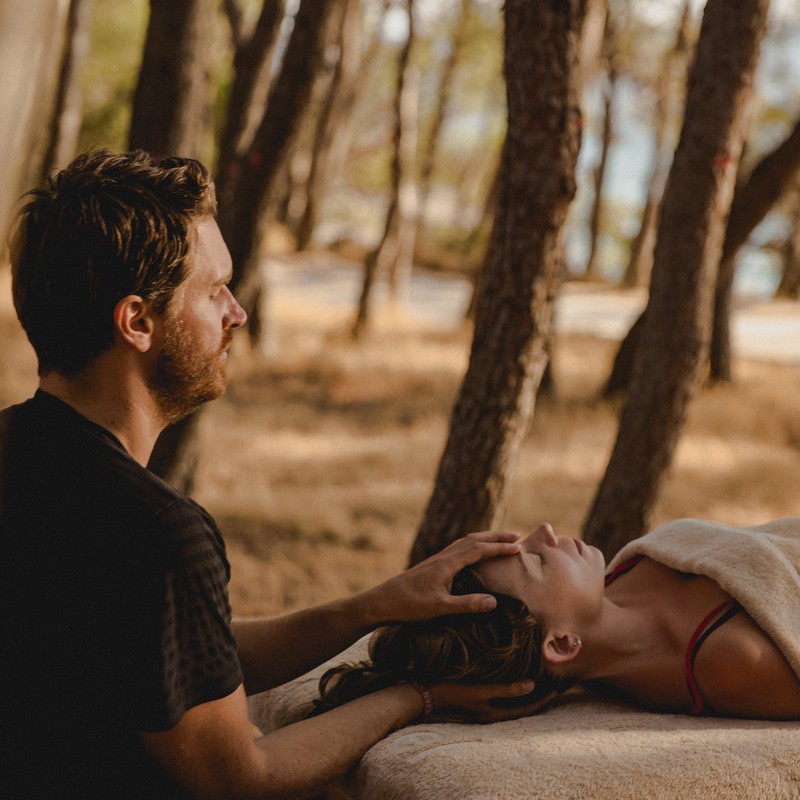The Treatment That Could Help Your Stress Headaches
So what exactly is craniosacral therapy?
Craniosacral therapy is a gentle, yet profound, holistic treatment intended to relieve stress, anxiety, trauma, pain, tensions and restrictions in the body. Originally created by American osteopath William Sutherland, the technique uses light touch to trigger the body’s self-healing mechanism. If you’ve had osteopathy before, you may have even tried cranio osteopathy, as many practitioners incorporate it in their sessions.
And as for how it works? Craniosacral therapists work with the rhythmic, wave-like motion of interstitial fluid – including cerebrospinal fluid, that bathes the brain and nervous system and allows for movement of neurotransmitters up and down the spinal cord – which practitioners say can be felt anywhere on the body. Recently discovered to be an organ, interstitial fluid is set to be the next big buzzword in the wellness world: read more about it here.
Some therapists, such as London-based Simon Baker – a leading accredited practitioner who studied at the College Of Craniosacral Therapy and now specialises in treating tinnitus – also work with the fascia (which surrounds and envelops every structure in the body and contains interstitial fluid) to help unwind the tight connective tissue and further relieve areas of tension in the body.
“Fascial unwinding is an extremely valuable therapeutic process through which physical and emotional blocks, whatever their cause, can be released,” Baker says. “Whether they are the result of physical injury, infection, disease or emotional factors, all traumas and tensions leave their mark and are held in the body's tissues in the form of restriction or constriction of some kind.”
How can it help with headaches?
Firstly, it can help relieve stress, which is a major cause of headaches for many. In fact, emotional stress is one of the most common causes of migraines. As craniosacral therapy sessions often leave people feeling in a deeply relaxed state, similar to the effects of meditation, they can take the body out of ‘fight or flight’ mode – a state of high alert that we can find themselves in far too often in today’s modern world of long office hours, after-work emails and 24-hour news cycles.

Headaches are also often caused by tension and issues within and surrounding the craniosacral system – which spans the membranes and fluid that surround and protect the brain and spinal cord, which extend down to the skull, face and mouth, as well as down to the tailbone area, as well as the attached bones and the spine itself.
That means if you're a teeth grinder, suffer from ‘tech neck’, sit at a desk all day and take little exercise or have generally poor posture, you'll likely be experiencing headaches too. All of the above can lead to the tightening of the muscles in the neck and scalp: the cause of tension headaches, which can range from slight to severe in intensity.
More widespread research is needed before we’ll see craniosacral therapy rolled out across the NHS, but research in its favour is mounting. One Icelandic study indicated that the treatment could alleviate migraine symptoms, a 2015 trial showed it was specifically effective and safe in reducing neck pain, and another in 2016 highlighted that it was as effective as trigger point therapy in the treatment of lower back pain.
Which other conditions is it used to treat?
“Due to its name, many mistakenly think this therapy only refers to the head, but craniosacral therapy works with the whole person and changes may occur in body, mind and spirit during and after sessions,” Baker says. “It can help with many different conditions and because it’s so gentle and non-invasive, it’s suitable for everyone from newborns to the elderly. Mothers and babies often come for problems associated with difficult or traumatic births.”
Some of the other conditions craniosacral therapy is used for include depression, anxiety, autism, tinnitus and ear problems, sleep difficulties, asthma, joint disorders, physical post-accident trauma and post-traumatic stress, irritable bowel syndrome, carpal tunnel syndrome, eye problems and severe menstrual cramps. Others also use it to help develop their personal mindfulness practices, to deepen their awareness of their bodies, to feel increased energy and to achieve a sense of balance.
What does a treatment involve?
Firstly, your practitioner will take a written case history, to find out about more about you and understand your reasons for booking in a session. You then lie fully clothed on a treatment couch, and will be encouraged to close your eyes and relax quietly whilst the practitioner uses a number of gentle hand contacts on your head and spine, including the sacrum (the triangular bone at the base of your spine), and other areas around your body such as your feet, stomach and chest.
Baker says these hand contacts allow therapists to tune into your craniosacral rhythm and look for any inbalances, tensions, restrictions or disturbances. They'll wait for these inbalances to flow more freely, helping your body to establish a more settled state.
And SL's verdict?
I'll caveat this by saying I get a lot of headaches. More so during stressful times, or when I'm run down, and from a young age too – I was diagnosed with scoliosis at 11 and have had worsening back, neck and head pain ever since. I've also tried a lot of treatments: physio, osteo, pain management, massages (in fact, it was during a recent massage that a therapist told me I should look into craniosacral therapy), and will give anything a go to get some relief.

Lying down at Baker's tranquil clinic, it felt as if I was about to have a spa treatment (comfy therapy couch, lights dimmed, tranquil music playing softly) and I found myself drifting into relaxation far quicker than I'd expected. At first, I couldn't feel anything out of the ordinary, but as the session continued something very strange began to happen... I could literally feel the areas of tension unblocking (keep in mind, I had no idea how craniosacral therapy worked at this point, as I – like many – had assumed it would involve head and spine manipulation similar to osteopathy) and energy flowing through different pathways as Baker moved his hands ever-so slightly in varying directions.
And afterwards? Baker told me there can be a short period of adjustment as part of the healing process, where people may become more aware of their symptoms for the next 24 hours, before they notice an improvement. And that was certainly the case for me. Exactly the same as after a deep tissue massage, I left the clinic completely blissed out... But soon experienced muscle soreness in all the areas of my neck, back and head I usually have issues with during periods of high stress.
Two days later, however, and I've never felt so good. Like, never. For the first time in I can't remember how long, I woke up without a headache. My neck feels good (not a word I've ever associated with my neck). I can move around freely without any stiffness. Unsurprisingly, I've already booked in for more sessions.
“Sometimes people report relief after only one or two sessions, and for long-standing problems further sessions may be needed,” Baker says, adding that he usually recommends a block of five weekly sessions, which can be transformative. “Some people find they benefit from regular treatment over an extended period of time and say that, as well as noticing improvement in their physical or emotional symptoms, they feel that they have more awareness of their own needs and strengths, and their quality of life has improved.”
For more information about craniosacral therapy, or to book an appointment with Simon, visit SimonBakerHolisticHealth.com
DISCLAIMER: We endeavour to always credit the correct original source of every image we use. If you think a credit may be incorrect, please contact us at info@sheerluxe.com.


